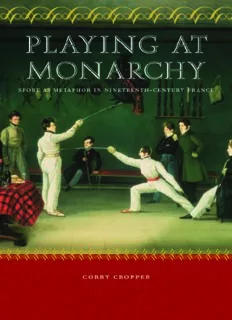
Playing at Monarchy: Sport as Metaphor in Nineteenth-Century France PDF
Preview Playing at Monarchy: Sport as Metaphor in Nineteenth-Century France
playing at monarchy Corry Cropper Playing at Monarchy Sport as Metaphor in Nineteenth-Century France university of nebraska press | lincoln and london Publication of this volume was assisted by a grant from the Brigham Young University College of Humanities. Portions of chapter 1 were originally published as “Playing at Monarchy: Le jeu de paume in Literature of Nineteenth-Century France,” French Review 70, no. 4 (2002): 720–29. Portions of chapter 4 were originally published as “Prosper Mérimée and the Subversive ‘Historical’ Short Story,” Nineteenth- Century French Studies 33, nos. 1 & 2 (2004–5): 57–74. © 2008 by the Board of Regents of the University of Nebraska. All rights reserved. Manufactured in the United States of America. ∞ Library of Congress Cataloging-in-Publication Data Cropper, Corry. Playing at monarchy: sport as metaphor in nineteenth-century France / Corry Cropper. p. cm. Includes bibliographical references and index. isbn 978-0-8032-1773-7 (cloth: alk. paper) 1. Sports—France—History—19th century. 2. Sports—Political aspects—France. 3. Sports—Social aspects—France—History— 19th century. 4. Sports and state—France. I. Title. gv609.c76 2008 796'.094409034 —dc22 2008024056 Set in Fournier MT. Designed by Joel Gehringer. Contents List of Illustrations vi Acknowledgments vii Introduction: xi Mountain Stages and How-to Manuals 1. Paume Anyone? 1 Representing Real Tennis after the Tennis Court Oath 2. The Spanish Bullfi ght in France: 23 Goya, Gautier, and Mérimée 3. Trictrac and Chess as Models of Historical Discourse: 45 Chance in the Works of Balzac and Mérimée 4. Of Rabbits and Kings: 85 Hunting and Upward Mobility 5. Fencing and Aristocratic Resistance during the Third Republic 119 6. Olympic Restoration: 155 Coubertin and the European Monarchy Conclusion: 181 Imitation and Resistance Notes 189 Bibliography 223 Index 235 Illustrations 1.Serment du jeu de paume (The Tennis Court Oath) 6 2.“Con razón ó sin ella” (Rightly or Wrongly) 24 3.Pepe Hillo 25 4.Tauromaquia 25 5.Seigneurs jouant au tric-trac (Lords Playing Trictrac) 48 6.Engraving by Régamey in L’escrime et le duel 142 Acknowledgments Combien je vous remercie de mon adresse. Charles Baudelaire, Le spleen de Paris I owe the original idea for this book to friends in my racquetball group. After getting yet another bruise in the back from an er- rant ball, I decided it would be better for me to spend more time researching sports than actually playing them. The bruises also led me to approach Prosper Mérimée’s tale “La Vénus d’Ille” in a new way. The narrative’s main character is an accomplished ten- nis player, a star of the court. Following a particularly important match (on the day of his wedding), he ends up dead. I had worked on Mérimée’s literature as a graduate student, in this story study- ing the construction of the supernatural. But I now came to his text with a new understanding of the connection between racquet sports and pain. So instead of looking for the cause of death in the details surrounding his marriage or in the testimony of his bride, who claimed that a moving statue killed him, I decided to look for reasons in the way he approached the game itself. Can playing tennis actually kill you? The answer, as you will see in the pages that follow, is yes. And so I begin by thanking Allen, Michael, Lee, Lanny, Enoc, Juan, Todd, Brett, and Kerry, whose errant “kill shots” put me on the path that led to this book. viii| Acknowledgments I am deeply grateful to the many people who have given me feedback on the manuscript as it was in various stages of prepa- ration. Thanks to my colleagues at Brigham Young University: Ed Cutler, Yvon LeBras, Daryl Lee, Marc Olivier, and Matthew Wickman. A special thank you goes to my friend and colleague Scott Sprenger, who read so much of the fi rst draft. Thanks also to colleagues at other universities who provided invaluable feedback and support along the way: Scott Carpenter (Carleton College), Antonia Fonyi (cnrs⁄item), Kathryn Grossman (Penn State University), Dorothy Kelly (Boston University), Armine Mortimer and Emile Talbot (University of Illinois), and Allan H. Pasco (University of Kansas). I must also thank the numerous friendly people I met in the world of trictrac (a now nearly forgotten board game) and paume (also called “real tennis”): Thierry Depaulis, David Levy, and Philippe Lalanne of the trictrac research group; Joe Wells, who graciously agreed to play several games of trictrac with me; Anthony Scratchley and Angus Williams, the former and current head pros at the paume court in Fontainebleau, who offered me a warm welcome; and Richard Travers, who translated an 1862 work about paume written by Eugène Chapus and Edouard Fournier. I also wish to thank Cordell Cropper and Susan Cropper for their encouragement throughout my entire career; Marvin Gardner and his assistants at the byu Faculty Editing Service; Elizabeth Moesser and Glen Young for their help in proofreading and source checking; and Debbie Van Ausdal and Kathleen Allen for their generous logistical support. The Brigham Young University College of Humanities, Department of French and Italian, Center for the Study of Europe, Acknowledgments | ix and the Kennedy Center for International Studies have funded re- search trips and granted me release time to complete the project. I thank them for working with me. Thanks are also due to the entire team at the University of Nebraska Press, which has effi ciently and politely guided me through the last stages of revision and publication. I am also grateful to the employees of the Bibliothèque Nationale de France in Paris, who kindly helped me locate many obscure articles and books necessary for the completion of this project. Finally, I express my love to my wife, April, and to our chil- dren, for their many years of patience and support.
Description: